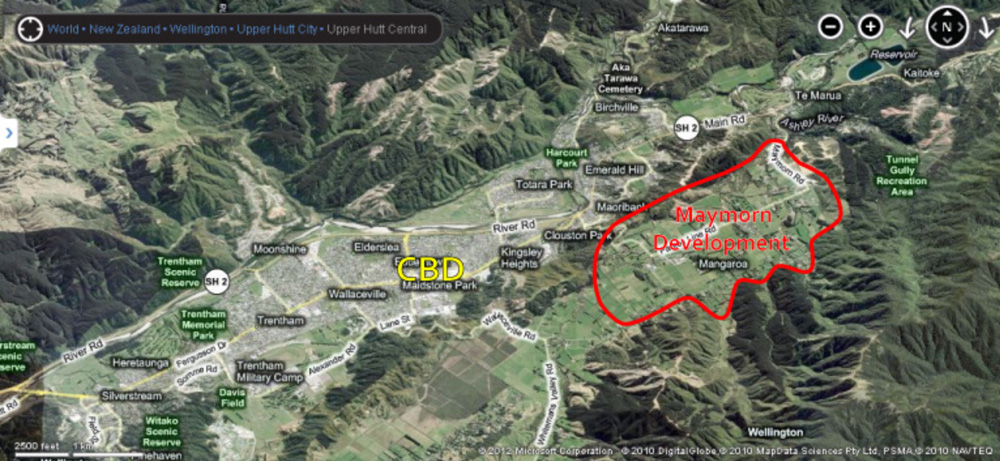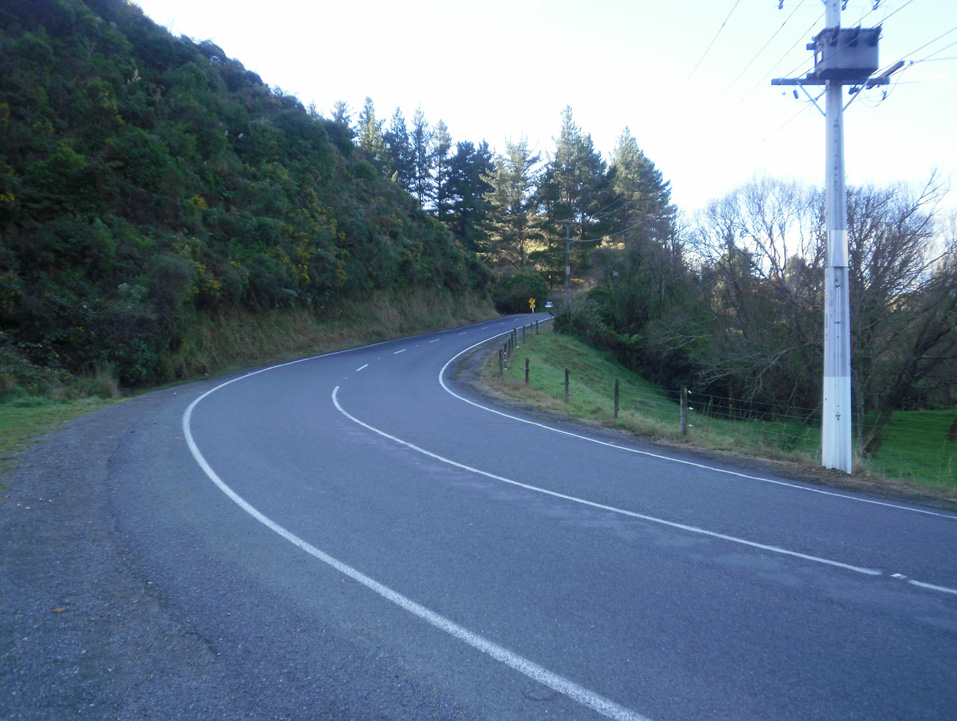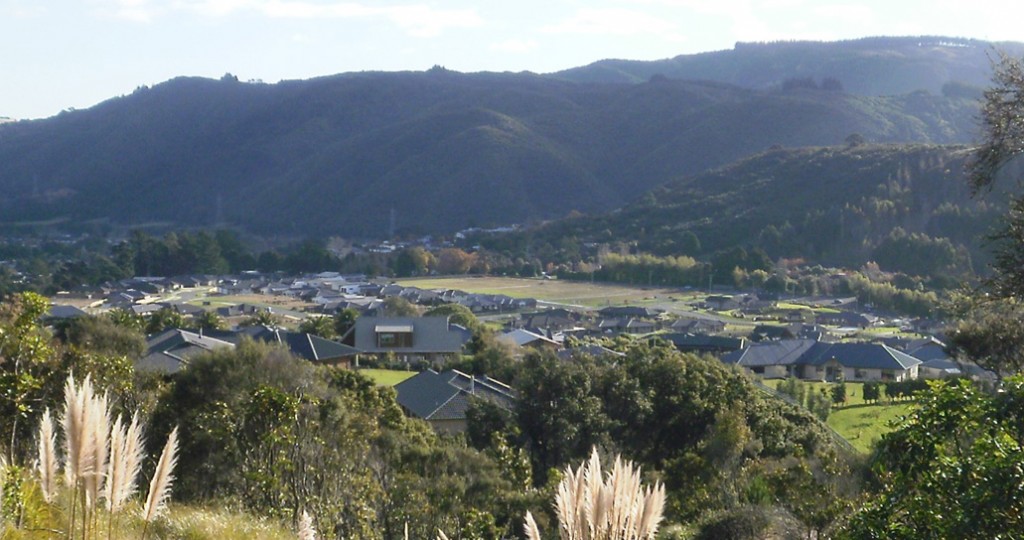Today: a guest writer:
I’m writing this guest post about a proposed housing development in Upper Hutt, (so not quite Wellington, but we’re still part of the Wellington region, right : ). For those still struggling to find the relevance to this blog, remember this post? (“Upper Hutt State of Mind†song).
Now this new development of some 1800 houses is being put forward by the Upper Hutt City Council as a major area for “urban†growth. The area in question is in Maymorn; for those who are wondering it’s in a rural valley directly east of the upper Hutt Valley, and currently has lifestyle blocks and smallish farms. Shown here:
Now this is where I try and make sense of this push for growth on this patch of farmland. First of all access to public transport. Fortunately there is already a railway station at Maymorn, so that’s a good thing right? The problem is that its part of the Wairarapa line, so it gets a total of 5 trains each way a day… That might be ok if I’m commuting into the city from the Rapa every day, but not so much if I’m living in a supposedly urban area and I want to do activities that mostly happen where everyone else is, i.e. Upper Hutt and Wellington.
The next issue is one of topography, something that Wellingtonians know so well. The problem is that topography makes certain modes of transport difficult, but we’re told the opposite will happen in this development:
“A priority at Maymorn is to encourage reduced vehicle dependency by providing good access to and encouraging the use of public transport, walking and cycling.â€
You can encourage walking and cycling as much as you like but when you’re faced with the start of a windy hill (shown below) to directly get to Upper Hutt’s CBD, most people will be heading back home for the car keys.
But most of these issues I could live with, because we’re being sold a fantastical vision by the Council. A green nirvana that has all the buzz words – sustainable, green growth, energy efficiency. “Development at Maymorn will minimise use of limited resources such as land, power, fuel and water. Best practice sustainable water practices will be implemented and housing will be sited and designed to maximise energy efficiency.â€
They almost started to get me excited, but then I took this photograph of one of the current developments in Upper Hutt. On all of those houses shown below it’s hard to make out any solar hotwater heating systems, any solar panels or even any rainwater tanks?? North is towards the right-hand border of the photo, and I really wouldn’t want to guess how many of those houses have been designed with regards to where North is (where the sun is).. But I would guess not very many. You see in this new world of the Kardashians, and the GC on tv, even the building industry leaves their brains at the door. The basics are bypassed, like that if you design a house with the sun in mind, you get free heat and light for the day. So I’m starting to think that a sudden shift to a green building philosophy at Maymorn is looking decidedly shaky, and I was just starting to get excited about a green utopia.
There is a fairly easy answer to the question of where is best for Upper Hutt to grow in the future. Its in an area where there are already schools, libraries, dairies, shops, trains, buses, all waiting to be used. The place is called Upper Hutt, and its not too hard to find fresh flat green land to build on that’s within the valley.
I’m not anti-development by any means, as my job depends on the building trade. But I’m just not into stupid development. There is simply no good reason to isolate potentially 4,000 new residents by herding them into a cow paddock, and in doing so limit their aspiration of being the best Hutt bogans they can be. This strategy will almost certainly make them car dependent while fuel prices continue to rise, segregate them from the rest of the community and all of its services, and waste loads more unnecessary money on new infrastructure that has to be run all the way out into the wop-wops.







Just wondering – if the people that go to live in Maymorn don’t wear black Metallica T-shirts cos they are wearing home-spun wool jerseys, and don’t drive Holdens cos they are riding their donkey, can they still be bogans? Perhaps they don’t aspire to be the best Hutt bogans that they can be?
and – does this guy qualify as a Bogan even if he only has one eye?
http://www.flickr.com/photos/38720450@N06/6134931363/in/pool-41894169203@N01
Garth – But then again there is this:
http://www.stuff.co.nz/oddstuff/7129266/A-bogan-by-any-other-name
“The Oxford Dictionary has revised its definition of the word bogan but Kiwi bogans are unlikely to agree. Bogan was included in a list of new word entries Oxford Dictionary issued this month. The word has long been part of the New Zealand and Australian vocabulary and recognised as slang for someone who is working class, listens to heavy metal music, wears jeans and black t-shirts, and could often be spotted with a beer in hand, while enjoying a barbeque with mates. That’s how PhD graduate and bogan researcher Dave Snell defines it, but the Oxford Dictionary’s definition isn’t as broad.
The dictionary described bogan as being an Australian and New Zealand informal word, meaning: “A boringly conventional or old-fashioned person,” or “an uncouth or uncultured person”.
“As a bogan I’m quite offended at the idea that the definition includes an uncultured person. I think it’s just a different culture,” said Snell.
“Bogan culture takes a lot of New Zealand culture characteristics. It’s almost like New Zealand culture in a concentrated form.”
If 4000 houses are developed in Maymorn, likelihood is that the Upper Hutt line would be extended and suburban trains would run there. As such it’s a pretty sensible place to build a suburb.
>On all of those houses shown below it’s hard to make out any solar hotwater >or even any rainwater tanks??
There is about 3 billion litres capacity at Twin Lakes and WRC are currently working to increase that by 400 million litres. That’s 8500 litres for every single person in the region, and it isn’t the only water storage in the region. The extra 400 million litres is going to cost $5million. (They’re doing some earthquake strengthening at the same time which raises the price, but doesn’t increase capacity.) So that is 80 litres of storage per dollar.
On the other hand, a quick Google for plastic water tanks suggests 10,000 litres will set you back about $2k. Plus delivery and installation. Say $3k total, for only 3.3 litres of storage per dollar.
That’s a pretty steep price for the water when compared to Twin Lakes. And it isn’t even drinkable water, unless you’re happy to drink the stuff that runs off your roof.
All I heard was that west Auckland and Upper Hutt are the bogan capital’s of New Zealand.
Jeremy there’s probably well over 1,000 people living in the 10 year old+ development at Riverstone terraces, and they still haven’t been given a simple bus service yet.. So I don’t think its automatically a case of build it and the council will provide services to you. The general population shouldn’t be subsidising the development costs of new subdivisions. Large scale developments should have to meet certain criteria, like ease of movement, access to community amenities, infrastructure spend. Thats just me anyway, maybe I should be trying to get a planning job at council!
At risk of offending the good folk at Upper Hutt City I agree with you Sav. All the evidence is that the further you spread out an urban area the greater the costs of maintaining its infrastructure, the higher the level of car dependency etc. We haven’t got a huge amount of genuine rural land in the Wellington/Hutt area as it is and seeing more of it disappear into suburbia will be a loss. I’d also suggest that there will be real issues Jeremy in extending the regular rail service (I may be wrong) for three reasons – first it obviously extends the journey implying impacts down the line, second the line is I think only single track from Upper Hutt north, and third I don’t believe it is electrified.
Upper Hutt has already allowed / promoted development of several satellite subdivisions, and doesn’t appear to have done any of them very well. I recall all the hype marketing of Mount Marua (you know ‘fantastic rural outlooks’ etc – all built out by subsequent homes), which frankly just looks like an out of the way and not particularly flash suburban residential development. There appear to be few facilities – if any – just houses. I agree that Upper Hutt would be much better to focus on brownfields redevelopment and infill within the existing urban area, but then that wouldn’t make the same easy money for developers, as the somewhat more thought requiring redevelopment options.
I must admit that there are several things about this development proposal that I just don’t understand. Actually, there are many things about Upper Hutt itself that I just don’t get, such as why they want to live there at all, given that commuting into Wellington is such a bore, unless they are retired – in which case why not go live on Kapiti Coast, given that it has better weather. There really is no sign of life in Upper Hutt itself, in terms of the urban area – i would dearly love there to be something, but it is sadly devoid of anything other than burger bars and used car lots. There is the wonderful building for the Upper Hutt called, i think, Expressions, but i’ve never seen anything advertised as going on there to draw me out from Wellington harbour. So I’m not sure about the case for the Upper Hutt at all.
But Maymorn makes even less sense. Situated at the extreme end of the Hutt, it is the remotest of all. Given the lack of work in Hutt, both Upper and Lower, potential residents will have to commute the entire length of the valley every single day, into Wellington. That’s going to be on either one of those few trains, or in their car, whether Holden or Nissan Skyline. While I admire the proposal to have an insistence on solar water heating etc, Sav does have a point that : why aren’t the Hutt councils demanding that anyway? The curiously named Mount Marua subdivision nearby (no sign of a mountain, and they have flattened out any hilly features into a bland flat plain) is just a soul-destroying morass of suburban hell, with tedious bland mass housing, identical roof pitches, plonked hither and thither, with no thoughtful relationship to the sun or to the street – it is an architects nightmare, an urbanist’s tragic horror story, and evidently, a suburbanite’s wet dream.
If Maymorn really wanted to be a green suburb, it would need to be completely different. For a start, it would need to be self-sufficient in terms of power, water, transport, food and jobs. Housing would need to be very different from the Mt Marua model of separate, detached dwellings, and instead be a very integrated mix of dwellings with common party walls, common green spaces, common working areas, and bugger all car-parking as there would need to be bugger all cars. There are precedents for this in NZ – plenty of them overseas of course, but in NZ they are few and far between. The one I am thinking of however, is the Beacon Pathway development up north. Now that is truly revolutionary.
jeremy…. kiwi rail and greater wellington have absolutely no plans to expand regular rail services from Upper Hutt to Maymourn, even if the development goes ahead. It would need 6-7km of electrification and probably double tracking, all very expensive and not in anybodys plans.
The hearing for Maymourn was very interesting, obviously not a tuely sustainable subdivision. Greenwash has been applied liberally to this development.
Great guest post Sav. A good commentary on what will be a huge green elephant for UH ratepayers
Why not just come out call it what it really will be (if it gets built that is). A satellite suburb that has nothing special going for it. If anything, it will be the exact opposite of what it espouses, i.e. “livable”. The only people who will end up residing there will be rich, stupid ones.
UHCC are putting the cart before the horse when it comes to transport. In the “good old days”, land developers got the inside word on where the next train station would be built and start buying up property around it because they knew it would increase in value. The developers will probably be expected to foot the bill on that one if so, in fact if I was the UHCC I would make it a condition of consent! But then
When will Kiwirail/GWRC think about putting the Maymorn station to use as a terminus. Simple – they won’t. The most that they will do is expand the Park & Ride facilities at UH Station so that worker bees can drive over the hill to catch the train in from there. Sustainable much?
If they want to generate their own power, why not plonk a wind/solar farm in there somewhere, instead of on each house? Economies of scale, and all that, etc.
I remember that there was a much smaller development that was based right near the UH station (in fact just over a block or two away from the UHCC chambers). Maidstone Quarter IIRC. Was this more sustainable than Maymorn due to it’s location but lack of “Green Credentials”? We’ll never know, as UHCC (it’s then competitor for new developments) shot it down for (what looks like underneath the surface) the very same reasons that they are promoting Maymorn (livable, close to amenities, rah-di-rah).
Hmmm, would that mean that there was potentially a conflict of interest?
Councils should stay out of the land development game, except where there is an extreme and urgent need for it. If they are to get involved, can’t they at least hire someone who knows what the hell they are talking about?
As has been said above, why don’t they ease the red tape around potential infill first and THEN focus on greenfields projects that have ever-increasing costs of infrastructure.
YEESH!
Quintin, true that currently there are no plans to extend the Hutt line north to Maymorn, but extending electrification north of Upper Hutt has been part of GWRC’s long term plan for at least a decade. See GWRC’s Hutt Corridor Plan (2003) http://bit.ly/LFUtFp for new stations at Timberlea and Cruickshank Road.
One would expect a bit of joined up thinking between the developers and GWRC to eventually integrate Maymorn into the network as well if thousands of people are going to end up living there, although admittedly perhaps overestimates the nous of our planners…
The Hutt aint all that bad Maximus, sure the CBDs are shocking, in particular Lower Hutt which is basically a healthy money making shopping mall surrounded by dying businesses and for lease signs, but living in either Hutt has its pros like decent public transport for most areas, cheaper housing with a good plot of land, rates are good, and councils not swimming in debt.
I can sense a bit of Hutt jealousy there Max, just because you don’t have a sentinel tower watching over your domain like these: http://mp.natlib.govt.nz/detail/?id=31510&l=en
http://www.therealstevegray.com/2011/09/avalon-studios-given-heritage-status/2091308681_cd7ed0b757/
I should also point out that the Maymorn plan proposes a bizarre range of section sizes from 300m to 2000m squared, so some really quite compact housing in there too.. I’ve got no problem if you want a large section and a rural lifestyle, then go and buy a section there, but don’t expect public transport, flushing toilets, etc. It should be automatic that if council want to add 300m-500m lot sizes to the housing stock they could go quite easily close to central areas, after all thats typically how I thought cities grew. Then you wouldn’t need to be thinking about electrifying the train further north.
Sav – who exactly is proposing the plan change? I thought it was a 3rd party who was after a quick buck – but you appear to be saying that it is the Upper Hutt Posse (Council)itself? That right?
It’s definitely being led by Council, it’s already been voted through by councillors, they just have to push through a district plan change now. Can’t see a developer’s name on it yet. They got 450 negative submissions on the Maymorn plan, so thats about 1% of the UH population.